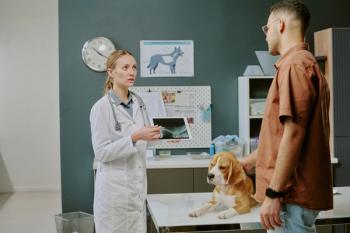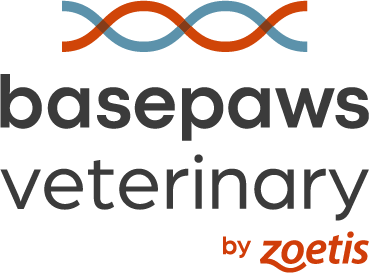
- dvm360 November 2022
- Volume 53
- Issue 11
- Pages: 56
Why you should add genetic testing to your practice

Today’s pet parents want personalized care
As veterinarians, the life-altering power of the human-animal bond is something that we have always appreciated, and numerous recent studies have confirmed this phenomenon for the rest of the world. Ninety-five percent of pet owners now consider their pet a part of their family, and 87% of pet owners report that they have personally experienced the mental and/or physical health benefits of the human-animal bond.1 Today’s pet parents want the absolute best care possible for their loved ones, and it’s important to deliver that care by utilizing the most up-to-date information available to us. We must continue to advance how we render care in order to effectively meet the changing needs of our clients.
Early detection is vital
Genetic testing in some form has been available in human medicine for decades and has been instrumental in early detection of many treatable diseases. Perhaps the most familiar example is the now-routine genetic testing for hereditary breast and ovarian cancer caused by mutations in the BRCA1 and BRCA2 genes. Individuals who are identified as having these mutations while still free of clinical disease are able to make proactive decisions with their healthcare provider in order to decrease their future cancer risk.
The great news is that we finally have the technology at our fingertips in veterinary medicine that is affordable, accessible, and allows for the early detection of many life-altering conditions in our pets. A shift from reactive to proactive medicine is what is needed to allow pet parents to partner with their trusted veterinarian in order to provide the absolute best care possible. Early detection of risk factors can have lifesaving results in your patients.
Elevate your wellness
In the past, a veterinary wellness visit was a chance to update vaccinations, prescribe parasite prevention, and provide a physical exam. Over the years, that has evolved to often include laboratory tests such as blood chemistries, complete blood count, and urinalysis. In some cases, radiography, ultrasonography, and other imaging modalities are performed. However, what if there was an easy and affordable way to provide our pet parents with even more personalized care? With genetic testing, now we can.
By combining a physical exam and screening lab work with genetic testing, we are now able to provide our clients with a comprehensive and predictive picture of their pet’s current health as well as note risk factors for future conditions that we can potentially address in a proactive manner. Educating our clients to help them better understand genetic testing is the first step. You may have already been asked about DNA testing by your clients.
When many clients think of genetic testing for their pets, the at-home tests that give information about dog and cat breeds likely come to mind. While genetic testing that provides details about a dog or cat’s specific breed makeup is interesting and can even offer some insight into breed-related conditions, the genetic testing platforms that are available today for veterinarians provide much more specific, relevant, and actionable information about a pet’s health.
Current tests can screen for numerous conditions in both dogs and cats. For example, the Basepaws Canine Baseline Breed and Health DNA test screens for genetic mutations associated with clinically relevant medical conditions, including dilated cardiomyopathy, multidrug resistance mutation (MDR1), epilepsy, von Willebrand disease, bleeding disorders, ocular conditions such as retinal degeneration, polycystic kidney disease, urolithiasis (bladder stones), and many more.
The Basepaws Feline Breed and Health DNA test + Oral Microbiome-Dental Disease screens for genetic mutations in 64 health markers associated with clinically relevant conditions including hypertrophic cardiomyopathy (HCM), polycystic kidney disease, retinal degeneration, progressive retinal atrophy, pyruvate kinase deficiency of erythrocytes, and many more. In addition, the oral microbiome test screens more than 600 relevant microbes and reveals risk for periodontal disease and tooth resorption. A risk score for feline gingivostomatitis soon will be included in upcoming reports.
Examples in practice
We can all agree that this technology is promising, but how do these tests fit into your general veterinary practice? Seamlessly incorporating these diagnostics into your wellness visits can benefit your patients and your clients, as well as your practice.
For example, a 1-year-old feline patient presents to your practice for an annual wellness visit. The client reports no concerns at home. After a thorough physical exam reveals no abnormalities, you discuss lab work (chemistries, complete blood cell count [CBC], and urinalysis) as well as the Basepaws genetic test. Your veterinary technician obtains a blood and urine sample and takes a quick swab inside the patient’s cheek. These samples are sent to the lab for processing.
The chemistries and CBC are all normal. However, the results of the Basepaws genetic test show this particular feline carries one of the mutations associated with a higher risk of developing HCM. We know that the majority of cats with HCM are not diagnosed before clinical signs are present, and at that point, the disease process may be too advanced to provide long-term quality of life.2 After discussing the results and risk factors with the client, you can work together to ensure early intervention can lead to slowing of the disease progression, if necessary. An echocardiogram is recommended. You now have useful information to be proactive about this particular patient to ensure we are doing everything possible for them.
Perhaps a different feline patient’s oral microbiome shows a high risk for periodontal disease and tooth resorption based on the DNA profile of the bacteria, fungi, and viruses present in the oral cavity. Even though this patient may be asymptomatic at the time of exam, we can now provide interventions based on these results that can mitigate or prevent certain diseases, perhaps even before traditional diagnostic tests indicate an issue.
I experienced the above scenario firsthand when I performed the Basepaws oral microbiome test on all of my personal cats. All tested in the low-risk category except for 1, who was shown to be high risk based on the oral microbiome results. At the time of diagnosis, this cat was only 10 months old and showing no clinical signs that my family had noticed. Based on this result, I examined her mouth more closely and immediately noticed that she did in fact have significant gingivitis in her caudal oral cavity. This simple test had brought an issue that I wasn’t aware of to light, and now I am better equipped to address her oral care moving forward in a proactive manner. Imagine that one of your clients with no veterinary knowledge is in the same situation. Their cat’s oral disease could have been progressing for years without them knowing. Now we can recommend biannual oral exams and additional dental diagnostics to better serve this client and patient.
It’s easy to imagine other scenarios that allow proactive intervention in ways never before possible. A pet at high risk for chronic renal disease can be started on a protein-restricted diet at an earlier age; a pet at risk for ocular conditions will now have a full ophthalmological exam biannually. Consider the canine patient whose genetic report revealed a mutation associated with inherited/idiopathic epilepsy. While not much can be done to prevent this condition or slow the progression, client education regarding how to recognize a seizure and what to do if it happens can give peace of mind and demonstrate that you are heavily invested in their pet’s quality of life and well-being. These are just a few of the countless examples of the information gleaned from a genetic test giving us opportunities to better care for our patients in a personalized way.
As demonstrated, the care that we are able to provide our clients and patients is much more comprehensive with the addition of genetic testing in our hospitals, and the benefits don’t stop there.
Success for your business
Not only does the genetic testing that you deliver offer clinically relevant and valuable information to your clients, but it can also provide your practice with an additional income stream. Risk factors noted in genetic tests performed in your hospital during wellness exams will need to be evaluated further. This will lead to additional office visits and examinations, imaging, and dental procedures. Working in a collaborative manner with our clients will necessitate additional follow-up diagnostics to address these findings, and this extra revenue can be extremely beneficial to your practice.
Additionally, client adherence to recommendations can often be challenging. When your plan for proactive care includes expanded diagnostics, increased periodic visits for medical progress, and lifestyle recommendations that include at-home care protocols, clients may want additional justification of the added expense. Providing supportive information, including results from their pet’s genetic report and other baseline diagnostics, can help you communicate your care plan more effectively and increase adherence to recommendations.
Conclusion
So, what will you do to elevate the care that you provide to your patients? Genetic testing has finally arrived in veterinary medicine. The great news is that it can be incorporated into your practice immediately. The platforms that are available to today’s veterinarians have the ability to transform the ways that we communicate and serve modern pet parents.
By utilizing the affordable and easy genetic tests available, we can help our clients ensure that their pets are taken care of in once unheard-of ways. Working with pet parents proactively not only benefits the pet patient, but also benefits your business by adding additional income and strengthening your relationship with your clients as you work collaboratively to care for their pets. By elevating the type of medicine that we provide, we are doing our part to ensure the human-animal bond remains the strongest bond in the world.
References
- International Survey of Pet Owners & Veterinarians. Human Animal Bond Research Institute. Accessed October 5, 2022. https://habri.org/international-hab-survey/
- Kittleson MD, Côté E. The feline cardiomyopathies: 2. Hypertrophic cardiomyopathy. J Feline Med Surg. 2021;23(11):1028-1051. doi:10.1177/1098612X211020162
Articles in this issue
about 3 years ago
Snuggles in San Diegoabout 3 years ago
Medical World News™: Fetch speaker sings medicinal musicabout 3 years ago
Rabbit endotracheal intubation: Yes, you can do it (Part 1)about 3 years ago
Obtain a cat’s consent for careabout 3 years ago
4 ways to advance as a veterinary technician or assistantabout 3 years ago
Psychotropic substances are poisoning petsabout 3 years ago
The overprotective pet ownerabout 3 years ago
Why shock wave therapy can’t be imitated in patient careabout 3 years ago
Busting oncology mythsabout 3 years ago
How and when to start paying back student loansNewsletter
From exam room tips to practice management insights, get trusted veterinary news delivered straight to your inbox—subscribe to dvm360.




